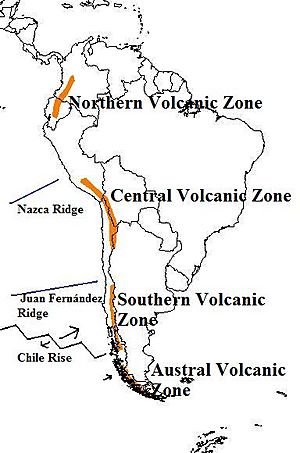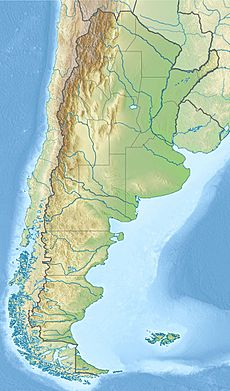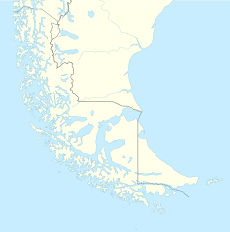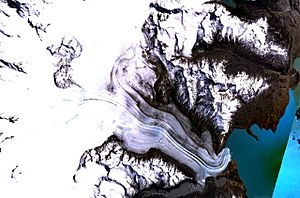Viedma (volcano) facts for kids
Quick facts for kids Viedma |
|
|---|---|
| Highest point | |
| Elevation | 1,500 m (4,900 ft) |
| Geography | |
| Location | Argentina/Chile |
| Parent range | Andes |
| Geology | |
| Mountain type | Subglacial volcano |
| Last eruption | November 1988 |
Viedma is a volcano that might be hidden under a huge ice field in South America. It's in an area that Argentina and Chile both claim. In 1988, it supposedly erupted, sending ash and rocks onto the ice. This caused a mudflow that reached a nearby lake called Viedma Lake. Scientists aren't sure exactly where it is because of the ice. Also, a spot once thought to be the volcano, called the "Viedma Nunatak", doesn't look like a volcano.
Contents
Where is the Viedma Volcano?
Viedma is located in the southern Andes mountains, in a region called Patagonia. It is southwest of a famous mountain called Mount FitzRoy. The lake of the same name is also southwest of where the volcano is thought to be. This area is very hard to reach, so not much is known about its volcanic past.
Viedma is part of a group of volcanoes called the Austral Volcanic Zone. This zone has six volcanoes that stretch for about 700 kilometres (430 mi). They are Lautaro, Aguilera, Viedma, Reclus, Monte Burney, and Fueguino. The southernmost one is a complex of lava domes and lava flows on Cook Island.
Not much is known for sure about Viedma because it's mostly covered by thick ice. In 1956, a scientist named Louis Lliboutry thought that volcanoes could erupt from cracks hidden under glaciers. He believed dark lines on the ice were ash from eruptions. Later, an expedition in 1958-1959 found pumice (a light, airy volcanic rock) on the Viedma Glacier, which supported his idea. Some scientists even think there might be a huge caldera (a large volcanic crater) hidden under the Southern Patagonian Ice Field.
The Mystery of the Viedma Nunatak
The "Viedma Nunatak" is a rock peak that sticks out of the ice. Many people thought this was the volcano's location. This idea came from observations in 1944-1945 and 1950, when people reported seeing fumaroles (steam vents) there. This led to the nunatak being called "Volcan Viedma." However, there isn't clear proof, and it's hard to collect rock samples. So, it's still debated if this nunatak is actually the volcano.
The nunatak is about 1,500 metres (4,900 ft) high above sea level. Most of it is buried under the Viedma Glacier. Only parts of it stick out. The nunatak is long and narrow, running from north to south. Some parts, especially in the south, look like craters or bowl-shaped dips. These might be young craters. However, rock samples taken from the nunatak are Jurassic metamorphic rocks, like gneiss and schists. No volcanic rocks were found there in 1958-1959.
Different studies have reported different numbers and sizes of these supposed craters. Some thought they were large, up to 4 kilometres (2.5 mi) wide. But later, these "craters" were believed to be glacial cirques, which are bowl-shaped hollows carved by glaciers. These often contain small lakes called tarn lakes.
How Viedma Formed

Off the coast of southern South America, a large piece of the Earth's crust, called the Antarctic Plate, is slowly sliding under the South American Plate. This process is called subduction, and it happens at about 3 centimetres per year (1.2 in/year). This movement is what causes volcanoes to form in the Austral Volcanic Zone.
The Austral Volcanic Zone is one of four volcanic zones in the Andes mountains. The others are the Northern Volcanic Zone, the Central Volcanic Zone, and the Southern Volcanic Zone. These zones are separated by gaps where there are no volcanoes. In the other zones, volcanoes form because the Nazca Plate is sliding under the South American Plate.
Scientists didn't fully understand the Austral Volcanic Zone until 1976. The volcanoes in this zone, like Lautaro, Viedma, and Aguilera, have similar rock types. The melted rock, or magma, from these volcanoes is special. It forms when the sliding plate melts and mixes with the Earth's crust and mantle. The rocks underneath the volcano are very old, from the Paleozoic era.
What Viedma's Rocks Are Made Of
Viedma, like other volcanoes in the Austral Volcanic Zone, has erupted rocks called andesite and dacite. These rocks contain small crystals called phenocrysts, which include minerals like amphibole, biotite, and plagioclase. Sometimes, pieces of other rocks, called xenoliths, are found in the volcanic rocks. These might show that the magma mixed with older rocks from the Earth's crust before erupting.
Viedma's Eruption History
Scientists have found ash from volcanoes in places like Laguna Potrok Aike and Lago Cardiel. Some of this ash, from about 26,000 to 57,000 years ago, might have come from Viedma. However, it's hard to be sure, as it could also be from Lautaro or Aguilera volcanoes. Because there's no clear evidence of a volcano at the Viedma Nunatak, the Global Volcanism Program removed Viedma from its list of active volcanoes in 2019.
Past Eruptions
There are many stories and reports of volcanic activity on the Southern Patagonian Ice Field. These include reports of ash falling, layers of ash on glaciers, and smoke rising from the ice.
A subglacial eruption (an eruption under ice) supposedly happened in 1988. This eruption left ash and pumice on the Viedma Glacier. These materials later caused a lahar (a destructive mudflow). The eruption melted some of the ice, creating channels. It's thought this eruption happened between September and November of that year.
What are the Dangers?
There are no big towns or cities close to the volcanoes in the Austral Volcanic Zone. Also, these volcanoes are not watched very closely by scientists. We know that some large, explosive eruptions have happened in the past. Other volcanoes in the zone, like Reclus and Monte Burney, had eruptions in 1908 and 1910. If volcanoes in this area erupt in the future, they could send ash far away. This could cause problems for air traffic and damage things directly.
See also
 In Spanish: Cerro Viedma para niños
In Spanish: Cerro Viedma para niños
- Lautaro (volcano)
- Aguilera (volcano)
- List of volcanoes in Argentina
- List of subglacial volcanoes




